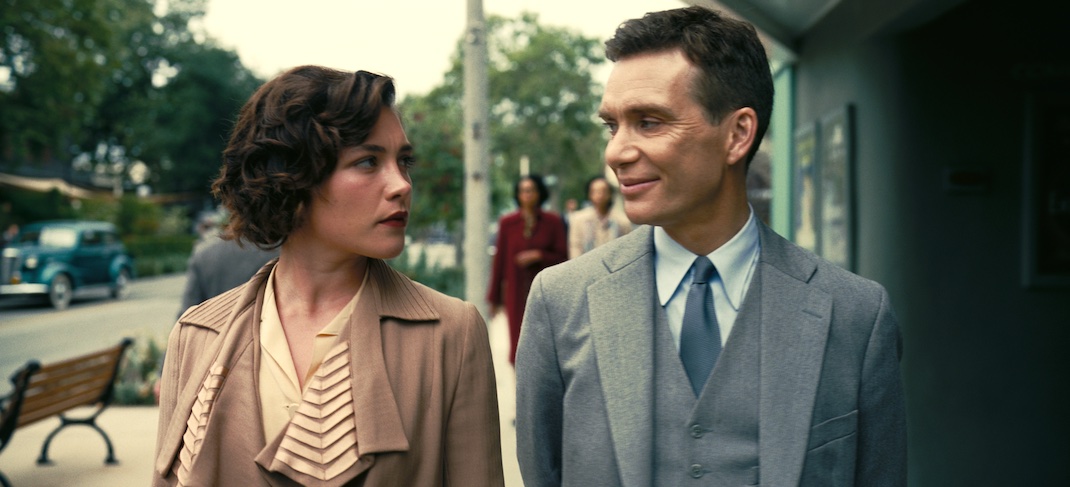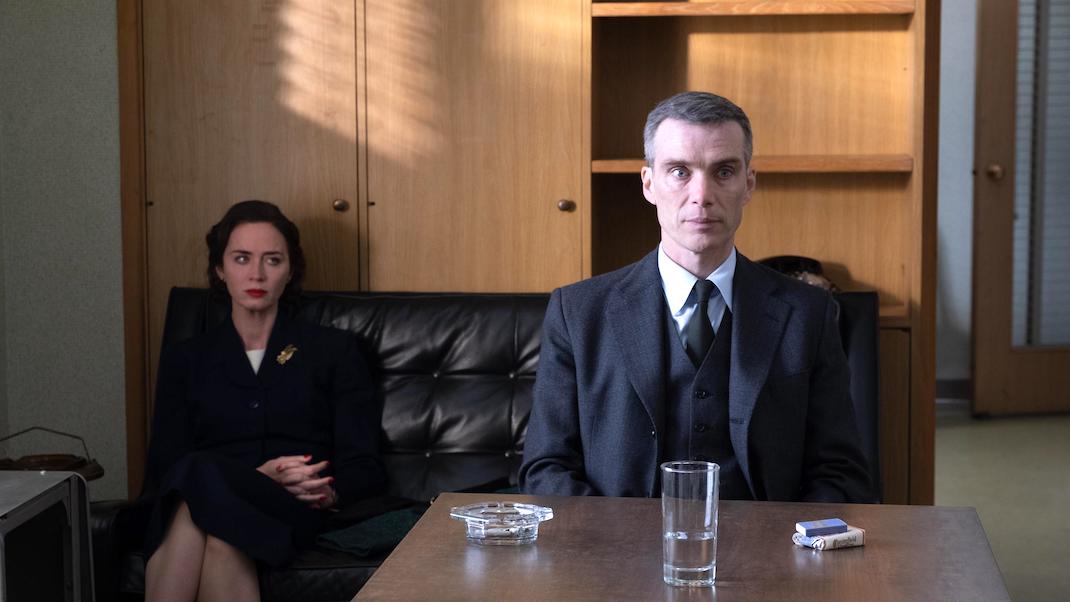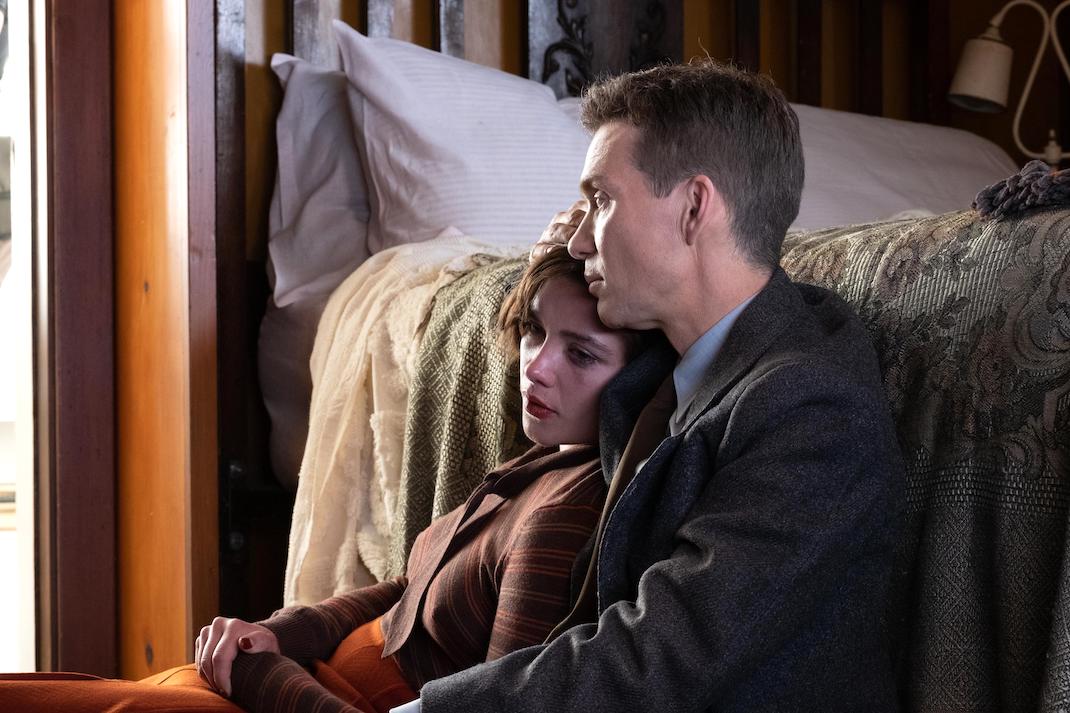Oppenheimer is part of My Summer of Summer Movies, in which I am attempting to see and review every movie that opens (in Chicago) between Memorial Day and Labor Day, 2023. Read all about this ill-advised plan here.
There is a throw-away line—one of the only moments of humor, surely—that caught my attention in Christopher Nolan's Oppenheimer (2023). Physicist Robert Oppenheimer (Cillian Murphy) has just had the government build him a whole town in Los Alamos, in the mesas of New Mexico, so he and other scientists can live with their families in secret isolation while they attempt to build the atomic bomb. In one scene, Oppenheimer is showing his wife Kitty (Emily Blunt) the little house where she and her family will live while he works in his lab.
"There's no kitchen," Kitty observes.
On first viewing, the line struck me as just an amusing observation about Oppenheimer's character. The great genius obsessed with his work, he is not the sort of man who would even notice that a house didn't have a kitchen: those sorts of domestic, real-life details elude him.
On my second viewing, however—as my understanding of both the film and my feelings towards it came into clarity—the line seemed to take on more significance, underlining the relationship between the filmmaker and his subject, and perhaps between the auteur and his art. For Oppenheimer is undeniably a tremendous achievement, an impressive and impassioned work of precise craft. It is also, however—like most Nolan films, for me—a construct built solely for work, in service of a specific and singular vision, with no room for the domestic pleasures of normal human life: humor, warmth, family, love. As one of cinema's most ambitious and meticulous architects, Nolan carefully constructs complexly beautiful houses that do not, ever, quite feel like homes. He may very well be a genius, but, over and over again, he forgets the kitchen.

Nolan is obviously passionate about filmmaking, and no one can deny that he is—in most senses—very, very good at it. And what a terrible inconvenience it must seem to him, I've often thought, that films are expected to be about human beings, in whom Nolan appears to take little or no enjoyment at all.
It is puzzling, and frustrating. I would never say that Nolan doesn't care about people: in fact, there is a deep vein of rank sentimentality running through his earlier oeuvre of prestige B-pictures. But he almost never makes me care about the people in his movies: they are usually just figures, to whom his overly complicated movies happen. To make me care, Nolan would need to spend time on their lives, their relationships, their feelings, their normal human experiences beyond and beneath the clever machinations of his plots. And none of that ever seems to interest him.
So I always feel there is an irreconcilable tension in Nolan's movies, between a deep sentimentality on the one hand, and a profound discomfort with normal life and simple feelings on the other. (What a suitable figure, in retrospect, Batman was for the director to explore.) And after a while all the puzzles Nolan employs start to feel like a device to obfuscate any deep feeling. If he plays enough games with time and structure, and fractures straight-forward stories and arcs into complicated loops, maybe we'll never notice how dull, how distasteful, or perhaps how discomforting Nolan finds simple emotion and essential human experiences.
(We notice. Interstellar is Nolan's most rawly emotional film, and the one his fans most often cite to refute claims that he is a "cold" director. But Interstellar did not originate with him: it began as a script that his brother Jonathon developed for cinema's greatest sentimentalist, Steven Spielberg. It's an odd film for Nolan, and the oddness makes itself evident. The film is powered by a father's profound love for his daughter, across convoluted distances of time and space. But at the end of the film, when father and daughter are at last together again, Nolan immediately shuts their reunion down before anything resembling an authentic human exchange can occur. It is almost comical: how quickly the daughter orders the father out of the room, before any messy feelings can spill out all over Nolan's picture.)
Nolan is a good enough filmmaker that his very distancing techniques—the careful cinematic walls he erects around emotion—achieve a sort of majesty. And Oppenheimer may well be his masterpiece, the perfect marriage of artistic sensibility and biographical subject. Métier, meet material.
For the Robert Oppenheimer who emerges in Nolan's film is—on the surface—all about the theory, all about the intellectual problem, all about the thing that must be created. But he is not truly cold: rather, he is deeply troubled, nearly neurotic, tormented by fears and emotions and passions that threaten to overwhelm him and turn his life to chaos. And so human considerations—his feelings for other people, the real-life consequences of his intellectual pursuits, the emotional ramifications of his creative obsessions—must be kept desperately at bay. When those feelings come, they are unwelcome, unbidden, intrusive and menacing flashes that threaten to rend the fabric of Oppenheimer's mind as he himself rent the fabric of the world.
In this, paradoxically, Oppenheimer is Nolan's most emotional film, and perhaps his most personal: a deeply intimate portrait of a man for whom intimacy itself seems anathema. It is an interesting chicken-or-the-egg question, reminiscent of the director's own fascination with non-linear narrative: Did Nolan make a film about Robert Oppenheimer because he related to him? Or is the Oppenheimer we meet in the film only like this because Nolan made it?
With a screenplay by Nolan, adapted from Kai Bird and Martin J. Shermin's biography American Prometheus, Oppenheimer moves back and forth through his subject's life, orienting us visually in one of three intertwined narratives—or two, or perhaps only one, depending on how we view the complicated devices Nolan is employing this time.
If we arrange these chronologically in biographical order (as Nolan deliberately does not), the bulk of the film focuses on a period from about 1920–1945, showing the life of J. Robert Oppenheimer (Murphy, astonishing in all timelines) from his student days through the creation of the atomic bomb. (Biographically speaking, this is the story we are here to see, and it is shot in full color.)
We first meet him as a young man, as a student in Europe during the '20s, and as an instructor involved with the left-wing (and Communist) causes that would give his enemies an excuse to crucify him decades later. We see him encountering and befriending the greatest scientific minds of his time, from mentors like Niels Bohr (Kenneth Branagh), Albert Einstein (Tom Conti), and Werner Heisenberg (Matthias Scheweighöfer), to contemporaries like Ernest Lawrence (Josh Hartnett), Edward Teller (Benny Safdie), Isidor Rabi (David Krumholtz), and many others. And we see him meet the two loves of his life: botanist Kitty (Blunt), who will become his wife, and psychiatrist and Communist Party member Jean Tatlock (Florence Pugh), who will become his mistress.

But it becomes clear that these events are shown to us as they were told, by Oppenheimer, during a humiliating and politically motivated 1954 Atomic Energy Commission hearing that would ultimately result in the revocation of his security clearance. (The color palette here is slightly washed out, perhaps just to evoke the loveless florescent lights of the hideous backroom storage space in which this shameful kangaroo court was convened.) This is important, because in hearing Oppenheimer's life story we are not watching an omniscient, objective account, but a subjective, highly selective one, curated by Oppenheimer himself, and limited by his own recollection and understanding. (So the story of Oppenheimer's career, up through the Manhattan Project, is nested within the 1954 hearing: this is one narrative, not two, which Nolan labels on-screen as "Fission.")

Finally, we keep cutting to 1959, to the point of view of Oppenheimer's ally-turned-adversary Lewis Strauss (Robert Downey, Jr.), the former chair of the U.S. Atomic Energy Commission. Strauss—for, as we learn, petty reasons—had been the unseen architect of Oppenheimer's persecution in 1954, and those events come back to haunt him during his Senate confirmation hearing to be Eisenhower's Secretary of Commerce. The 1959 story of Strauss's failed confirmation—which Nolan labels "Fusion," and films in black-and-white—is a separate narrative, then, from a separate point-of-view, containing as it does the only events in the film Oppenheimer himself neither witnesses nor recounts.

So even here, in the relatively straightforward, well-documented story of a public figure's life, Nolan turns narrative into a series of nesting dolls. I mean to be neither glib nor critical: the device is clever, and forces us to question the viewpoint (if not quite the veracity) of everything we see, and contemplate how the complicated narrative of one man's life becomes condensed and ensconced into "biography" in the first place. ("Who'd want to have to justify their whole life?" Strauss asks, about his own hearing, and his question is at the center of both. Though these are only "hearings," both Oppenheimer and Strauss repeatedly slip up and use the language of a legal courtroom: each feels, quite rightly, as if he's on trial, awaiting the moral verdict of history on his life.)
It is an interesting choice. It is even, from one perspective, an understandable one, to structure the film this way. The 1954 hearing was the moment Oppenheimer's reputation was destroyed, a prolonged bit of public flagellation Nolan suggests Oppenheimer participated in, at least in part, out of guilt and a desire to expiate his own sins. (Why won't you fight back? his wife asks him, as Oppenheimer politely allows all of his professional and personal failings to be read into the record.) And the 1959 Senate hearing, indirectly, is the moment that reputation began to be restored, as the scientific community took the opportunity of Strauss's confirmation to denounce what was done to Oppenheimer.
However—and here's where we must speak of those towering edifices to obfuscation Nolan builds—the fractured timelines and framing devices are doing a lot of work to distract us from a shallowness of substance. For if we imagine this film told chronologically, it would be hard to ignore how thinly developed its characters and their relationships to Oppenheimer truly are. Nolan gives nearly a third of his non-linear film over to Strauss, for example, and because of this Strauss seems important, as if he were present all along in Oppenheimer's life, and as if his petty machinations constitute a great and unforgivable betrayal of a personal friendship. But we never see this "friendship" that Strauss betrays: a few tiny encounters in which Strauss perceived that Oppenheimer snubbed him constitute almost the entirety of their personal relationship on-screen. (Perhaps—as one character suggests near the film's end—this is the point: that Strauss was unimportant all along. But, if so, why are we spending so much of this three-hour movie with him?)
And if Strauss's insignificance is the point, is this also the point with everyone Oppenheimer ever met? Nolan has some very good actors filling out Oppenheimer's cast of hundreds: in addition to those already mentioned, Gary Oldman, Dane DeHaan, Rami Malek, Casey Affleck, James D'Arcy, Alden Ehrenreich, Olivia Thirlby, Jason Clarke, Tony Goldwyn, Matthew Modine, and dozens of other recognizable actors wander through the crowded frame. We clock their famous faces—and their familiarity helps (a little) in keeping characters straight—but few of them are given more than a single scene, some little more than a single line. None, besides Murphy's and Downey's, register as actual characters: Oppenheimer is a couple of great performances surrounded by three-hours of extended cameos.

We can view the thinness of all those (mostly male) scientists and politicians as a creative choice, born of necessity (there are simply too many characters) and perspective (Oppenheimer, after all, did not particularly care about them). But where Nolan's aversion to human interaction becomes a bigger problem is in the characters of Jean Tatlock and Kitty Oppenheimer, whom the film treats shabbily when it bothers to consider them at all.
Both actresses are absolutely tremendous talents, but Nolan's screenplay gives them precious little to work with. Pugh spends most of her screen-time naked: she is either having sex or lounging around having stilted conversation afterwards, and neither activity is marked by an ounce of genuine emotion or a word of convincing dialogue. (These scenes are unusual in Nolan's almost entirely sexless oeuvre, and we can sense his discomfort with them. If you told me they were written by someone who had neither experienced sex nor conversed with a real-life woman, I would probably believe you.) Jean Tatlock in Oppenheimer is a fiery, irrationally mercurial femme-fatale—but she never comes close to seeming like an actual person.
Kitty Oppenheimer fares slightly better, but only late in the film, after she has been just there for most of the picture. We get brief moments where she seems to drink too much and get overwhelmed by parenthood. We get scowling looks at her husband, and scowling looks on his behalf. But we get nothing that speaks to an actual relationship with her husband, let alone of an intelligent woman and fellow scientist with a full life of her own. (The longest conversation she has with Oppenheimer is when they are first getting together, when, by way of "conversation," she basically reads him her curriculum vitae.)
To be clear, I think these choices are all intentional, and made out of fidelity to Nolan's tricks with point-of-view: These women exist in the narrative the way they do because that is how they exist in Oppenheimer's mind and memory. Of course the film ignores Kitty for much of its narrative: so did Oppenheimer. (It is notable that Kitty only comes into focus late in the film, when she testifies at the hearing. The public record paints a better, fuller picture of her formidable strength and intelligence than Oppenheimer himself could.) And of course Jean—his mistress—exists as a naked and neurotic sex-kitten. That is exactly how she exists in his imagination: first as an unobtainable object of lust and frustration, then as a messy inconvenience, and finally as a source of guilt—but never, really, as a person. The film is subjective, not objective—mimetic, not diagetic—and so we can't see her or know her any better than he himself does.

The same point could be made about a lot of things that could be considered weaknesses in Oppenheimer. For example, as many people have pointed out, there are no voices of color in the film. We see nothing of the Native and hispanic populations that were forced off land they'd been living on for generations to make room for the government's Los Alamos site, or the nearby rural communities that were poisoned by Trinity's fallout. (In the film, this land is barren and completely, conveniently unpopulated.) We see, I think, exactly one Black scientist at Los Alamos, who has no lines, though there were in fact a number of Black scientists and technicians who worked on the project. We hear nothing of the Navajo tribes impacted by uranium mining, or the shadow war in the Congo to control the mines that provided two-thirds of the uranium used in the bombs dropped on Japan. And, most glaringly, we see not a single Japanese face in a film about the invention of the bombs that killed between 110,000 and 200,000 people in Hiroshima and Nagasaki. Why? Because the bulk of the film is set within Oppenheimer's mind, and Oppenheimer did not think or care about these things. (In his life, the real Oppenheimer never once apologized for Hiroshima and Nagasaki, and neither does Nolan and Murphy's Oppenheimer.)
So none of this is a failure of the film, exactly, so much as it is a careful realization of Nolan's extremely limited vision. It is missing the point to critique the film's failure to achieve goals it did not have, or to review it as a sloppy version of a film Nolan never intended to make. Oppenheimer is not about Kitty Oppenheimer and Jean Tatlock, and it is not about communities of color impacted by the Manhattan Project, and it is certainly not about the American government's crimes.
But then the question with Nolan's films always becomes, for me, not whether they succeed, but what is the value of what it is he has managed to do?
After all the things Oppenheimer is not—a straightforward bio-pic, a relationship drama, a love story, a political treatise, a moral judgement—I am left with that oddly intimate portrait of a man for whom emotion is destructive and intimacy is impossible. And in realizing this goal, Oppenheimer, admittedly, succeeds like gangbusters. The achievement of the film is not to make conversations in sterile labs and stuffy conference rooms worthy of IMAX screens—though that is certainly impressive—but to represent cinematically the explosive turmoil inside of this one man's mind: his inability to make sense of the path of his life, or to grapple with the magnitude of the forces he has unleashed upon the world.

The Trinity test—the first detonation of an atomic bomb—is the climax to which the entire film builds, and it is worth waiting for. It is a truly stunning piece of work, as perfectly edited a cinematic symphony of overwhelming sounds and images as we've seen in a long time. It is the moment that broke the world, and it is the moment that broke Oppenheimer. We realize, when it comes, that this is what has fractured the space-time continuum of both the movie and the man at its center: it echoes forward and back throughout the film's non-linear depiction of his mind, creating ripples and rips in the fabric of Oppenheimer's being. In these moments—which manifest throughout the film as aural and visual hallucinations, really—Oppenheimer almost becomes a psychological horror movie, a cinematic imprisonment in a mind unable to grapple with itself and its own capacity for destruction.
They are undeniably powerful, these moments, when the damage Oppenheimer has done—on a personal level, and on a potentially world-ending level—threaten to overwhelm his careful control over his own mind. In this sense the film is fission itself, beautifully made manifest in one man's irreparably broken soul. (Murphy's performance is a revelation: he will almost certainly win, and probably deserve, the Oscar.) And the film itself is a manifestation of the tension I see throughout Nolan's work—the prioritization of work over relationships, the complicated avoidance and suppression of straightforward emotion—ramped up to operatic levels until it becomes the main subject itself.
And yet, I keep coming back to that question of value. What is it ultimately worth, this (admittedly powerful and well-constructed) cinematic representation of yet another tormented genius's mind? In the end, Oppenheimer is ultimately a small psychological study, dressed up in the suit and hat of a big historical epic. But what does it tell us we didn't already know? What light does it shine on human beings? Why is viewing the potential destruction of the world through the narrowly-focused lens of a single man's psyche worth more than all those other stories that Nolan deliberately avoided telling?
Men will literally destroy the planet rather than go to therapy. We knew that already.

1 thought on “OPPENHEIMER (2023)”
First-class, Michael, really good! Thank you.